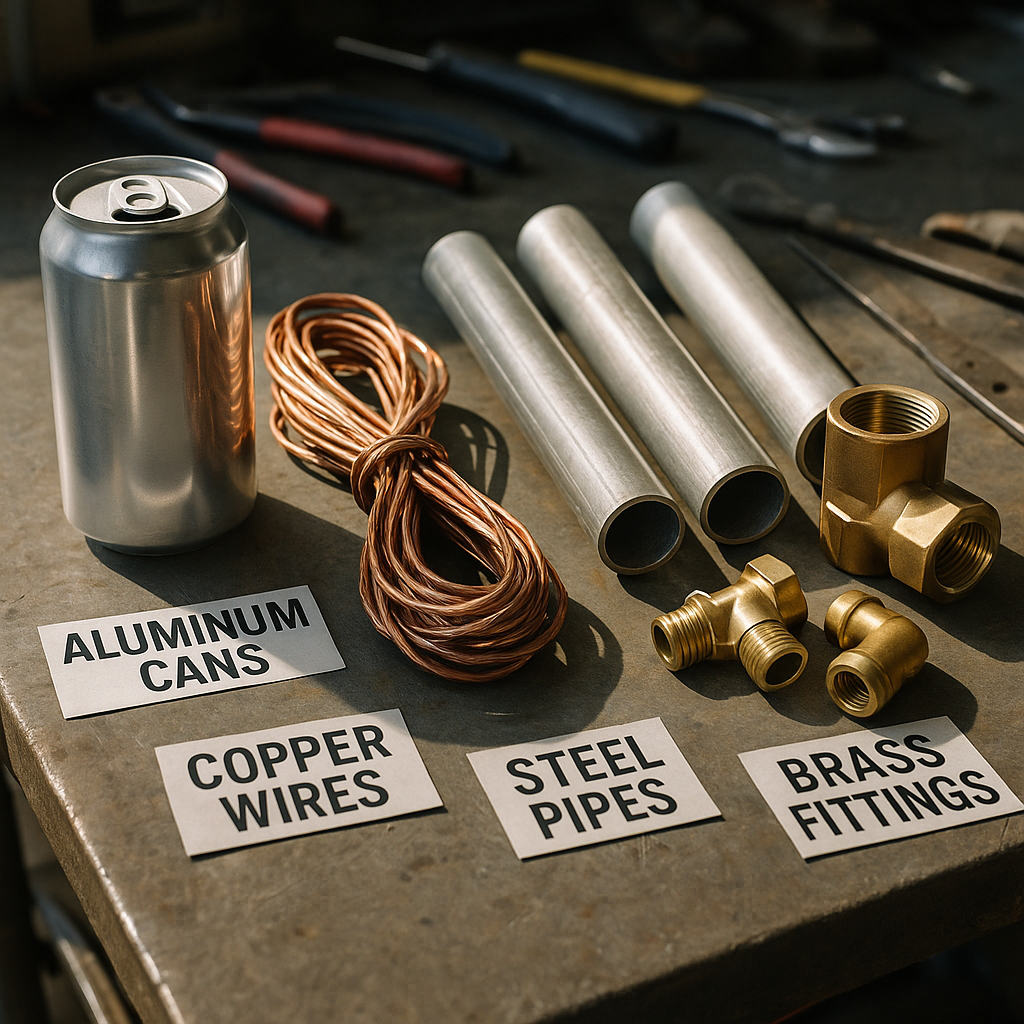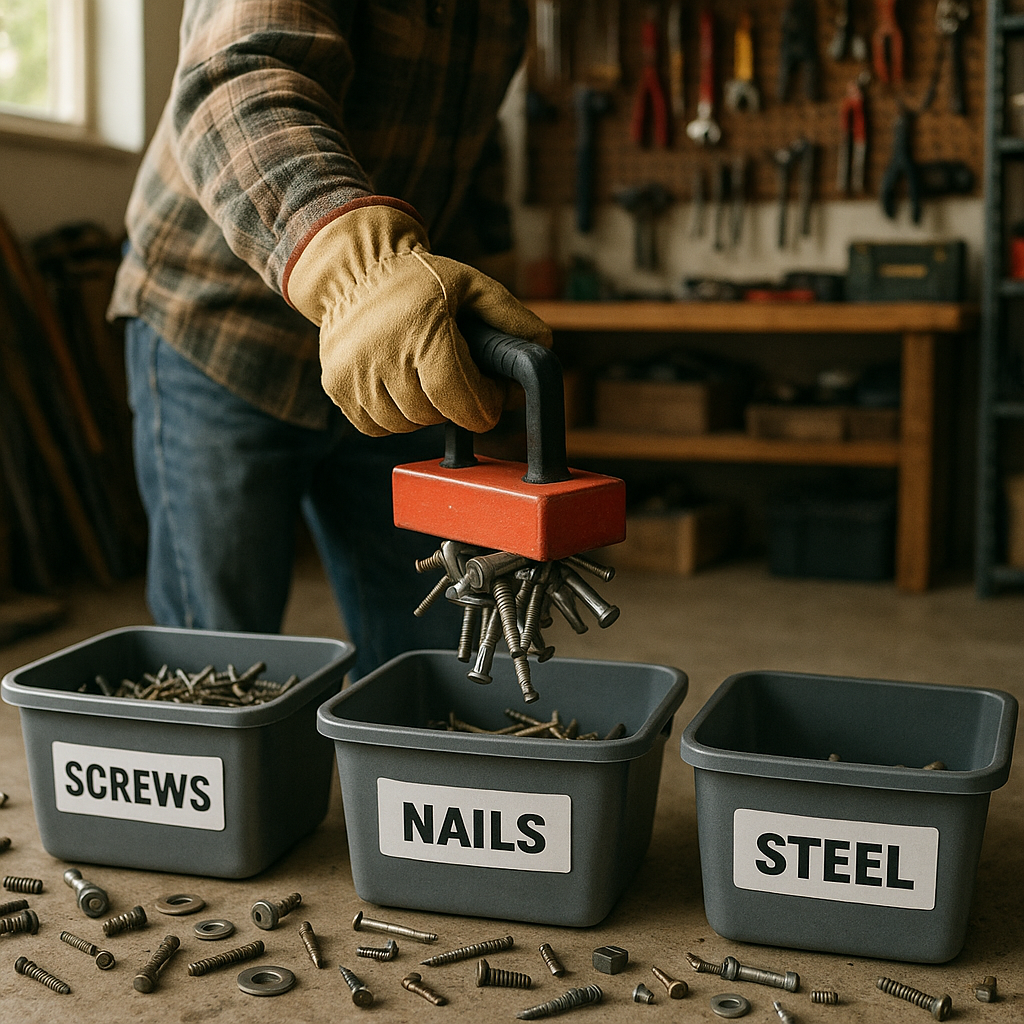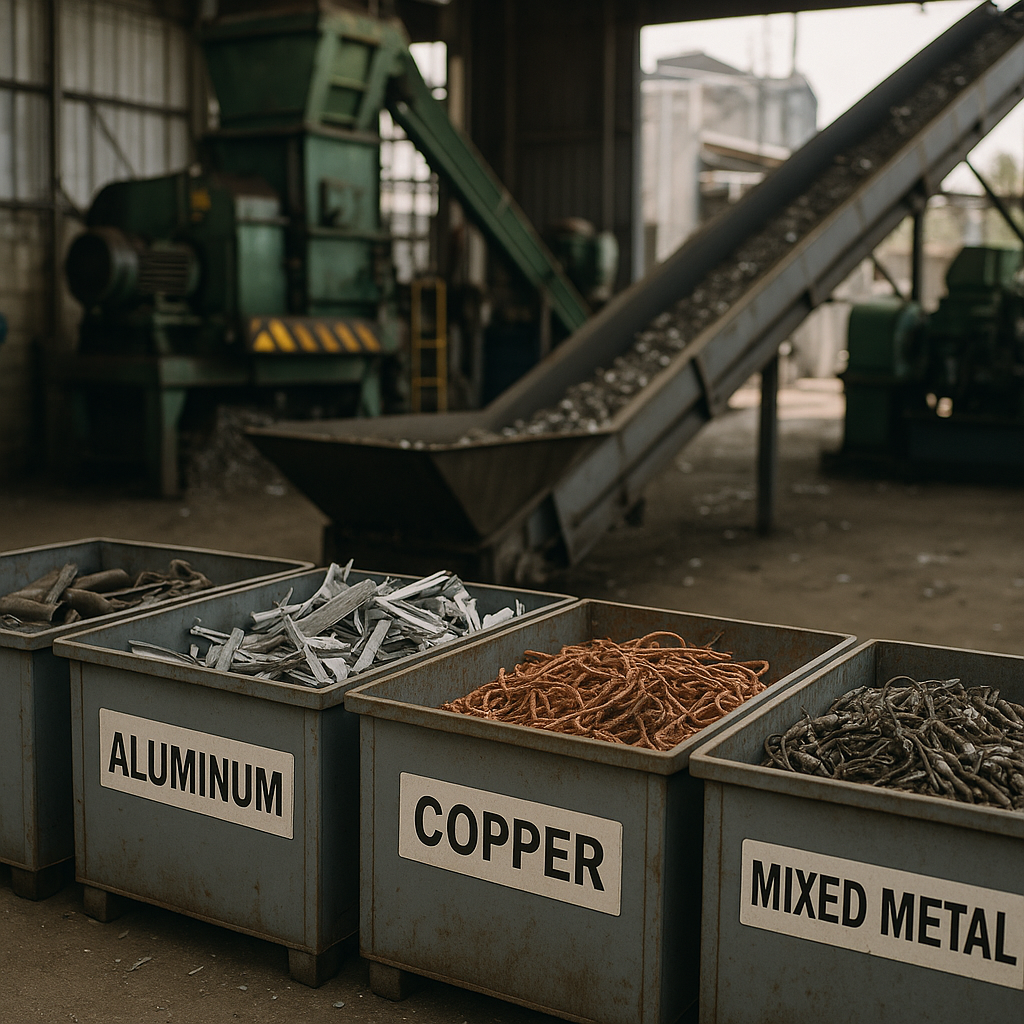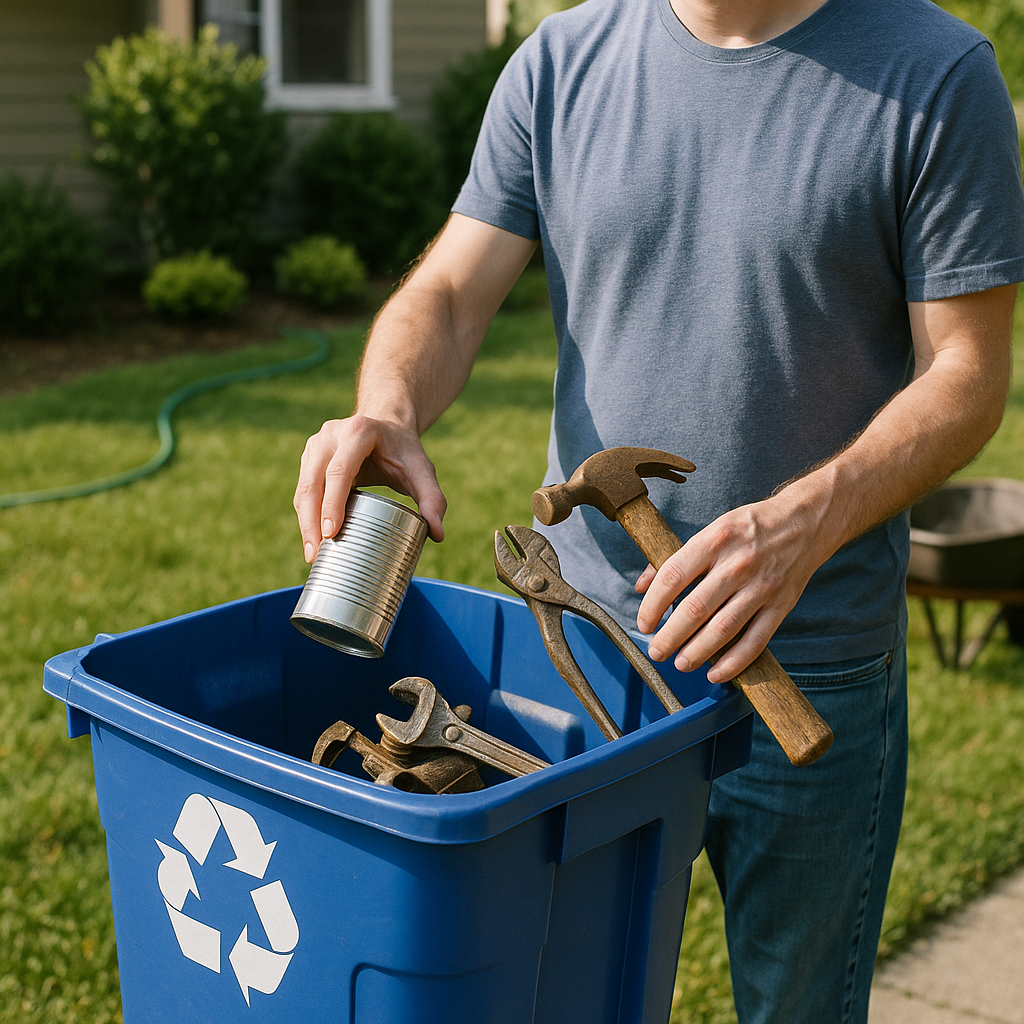5901 Botham Jean Blvd, Dallas, TX 75215
Metal Recycling for Beginners: How to Identify, Sort, and Profit from Scrap Metals
August 22, 2025Did you know that recycling one ton of steel conserves 2,500 pounds of iron ore, 1,400 pounds of coal, and 120 pounds of limestone? Metal recycling is one of the most effective ways individuals can contribute to environmental conservation while potentially earning extra income. As natural resources become increasingly scarce, recycling metals has evolved from an environmental choice to an economic necessity.
Metal recycling involves collecting discarded metal items, processing them, and converting them into raw materials for new products. Unlike many materials that degrade during recycling, metals can be recycled repeatedly without losing their properties. This characteristic makes metal recycling particularly valuable in our pursuit of sustainability.
For beginners, starting to recycle metal may seem overwhelming. Questions often arise about which types of metal can be recycled, how to identify them, and where to take them. This guide aims to simplify the basics of metal recycling, equipping you with the knowledge needed to begin your recycling journey confidently.
From distinguishing between ferrous and non-ferrous metals to understanding the step-by-step recycling process, we’ll cover the essential information to help you make informed decisions about your scrap metal.
What Types of Metals Can Be Recycled?

Recyclable metals are categorized into two main groups: ferrous and non-ferrous. This distinction matters because it influences how metals are processed, their market value, and their applications after recycling. Understanding these differences helps both businesses and individuals maximize the value of their scrap metal.
Ferrous Metals
Ferrous metals contain iron and are magnetic. They make up the largest volume of metal recycled worldwide and are known for strength, durability, and impact resistance, making them ideal for structural applications.
Common ferrous metals that can be recycled include:
- Steel (the world’s most recycled material)
- Cast iron
- Wrought iron
- Stainless steel (contains iron and chromium for corrosion resistance)
- Sheet metal
Everyday items containing recyclable ferrous metals include appliances like refrigerators and washing machines, structural building materials, vehicles, railroad tracks, farm equipment, and cast iron cookware. According to the Institute of Scrap Recycling Industries, the United States alone processes about 66 million metric tons of ferrous scrap annually.
Non-Ferrous Metals
Non-ferrous metals do not contain iron and are not magnetic. While the volume of non-ferrous scrap is significantly less than ferrous scrap, these metals are typically more valuable by weight. They are prized for conductivity, lightweight properties, and corrosion resistance.
Common recyclable non-ferrous metals include:
- Aluminum (recycling uses only 5% of the energy needed for new production)
- Copper (can retain up to 95% of its original value when recycled)
- Brass (an alloy of copper and zinc)
- Bronze (an alloy of copper and tin)
- Lead
- Zinc
- Nickel
- Precious metals (silver, gold)
You’ll find these metals in beverage cans, wiring, electronics, plumbing fixtures, gutters, and vehicle components like radiators. A single recycled aluminum can save enough energy to power a 100-watt bulb for up to four hours.
Identifying Recyclable Metals
The simplest way to distinguish between ferrous and non-ferrous metals is the magnet test. If a magnet sticks to the metal, it contains iron and is ferrous. If not, it’s non-ferrous.
Other identifying characteristics include:
- Weight: Ferrous metals are generally heavier than non-ferrous (except for lead)
- Rust: Only ferrous metals rust when exposed to moisture and oxygen
- Color: Many non-ferrous metals have distinctive colors (copper is reddish-brown, brass is yellowish)
Proper identification is crucial when recycling, as it affects the metal’s value and processing requirements. Scrap yards typically have different drop-off areas for ferrous and non-ferrous metals, with non-ferrous metals commanding higher prices per pound.
Both ferrous and non-ferrous metals can be recycled indefinitely without losing their properties. Recycling these materials conserves natural resources, reduces energy consumption, and minimizes waste in landfills. Steel recycling, for example, saves enough energy annually to power about 18 million homes for a year.
From industrial manufacturing to everyday household items, virtually all metal products contain some percentage of recycled content. Today’s steel products contain between 25% and 100% recycled material, making metal recycling one of the most successful examples of the circular economy in action.
How Do I Identify and Sort Recyclable Metals?

Correctly identifying recyclable metals is crucial for effective recycling and maximizing value. Distinguishing between different metal types ensures proper sorting, which benefits the environment and can enhance the monetary return on your recyclables.
The Magnet Test: Your Primary Sorting Tool
The most straightforward and reliable method for initial metal identification is the magnet test, which quickly separates metals into two categories: ferrous and non-ferrous.
To perform the magnet test, simply place a magnet against the metal item. If it sticks, it indicates a ferrous metal containing iron. If it doesn’t stick, it’s a non-ferrous metal.
Ferrous metals like steel and iron are magnetic and generally less valuable per pound. Non-ferrous metals such as copper, aluminum, and brass aren’t magnetic and usually fetch higher prices at recycling centers.
Visual Identification of Common Metals
In addition to the magnet test, visual cues can help identify specific metal types. Copper has a distinctive reddish-brown color, while brass has a yellowish hue similar to gold. Aluminum typically appears silvery-white but is much lighter than steel.
Steel often has a dull gray appearance and feels heavier than aluminum of the same size. Stainless steel can be tricky, as some types aren’t magnetic despite being ferrous. It usually has a clean, shiny surface that resists corrosion.
Physical Properties for Advanced Sorting
Weight and density provide further clues for metal identification. Copper and lead are noticeably heavier than similarly sized pieces of aluminum. This weight difference is apparent when handling these metals.
The sound test can also be useful for identifying certain metals. Aluminum produces a dull thud when struck, while copper and brass produce a more resonant ring. These subtle differences become more apparent with experience.
For unidentified alloys, specialized tests like spark testing can offer more definitive results. Different metals produce characteristic spark patterns when ground against an abrasive wheel, which experts can recognize.
Clean vs. Dirty Metal: Maximizing Value
Recycling centers pay premium rates for clean metals free from contaminants. Before recycling, remove attachments like screws, plastic components, or insulation from your metal items. For copper wire, stripping the insulation significantly increases its value.
Sort your metals into clearly labeled containers to maintain organization. Separate containers for ferrous metals, copper, aluminum, brass, and other non-ferrous metals will streamline your recycling process and maximize returns.
Transportation and Recycling
Once your metals are properly sorted, transport them to a reputable recycling facility. Many centers require minimum weights for certain materials, so be sure to check their requirements beforehand. For larger quantities, some recyclers offer pickup services, saving you time and transportation costs.
Be aware that current market conditions can affect metal prices. Staying informed about scrap metal pricing trends helps you determine the optimal time to sell your recyclables for the best possible value.
What Are the Steps in the Metal Recycling Process?

The metal recycling process turns discarded metal items into valuable resources for creating new products. This systematic approach not only conserves natural resources but also reduces energy consumption and environmental impact. Let’s explore each step of this journey.
Collection
The recycling journey begins with collection. Individuals, businesses, and industries gather metal items at the end of their useful life and place them in designated recycling bins. These materials come from various sources, including construction sites, manufacturing facilities, and household waste.
For individuals, common items include food cans, appliances, and electronics. Businesses often contribute larger quantities of materials from manufacturing processes or construction projects. Collection points may include curbside pickup programs, drop-off centers, and scrap yards that accept metal materials.
Sorting and Preparation
Once collected, metals undergo a critical sorting process. This step ensures different types of metals are separated properly before processing. Sorting typically happens at specialized recycling facilities using both manual inspection and automated technologies.
Metals are first categorized into two main types: ferrous (containing iron) and non-ferrous (without iron). A simple magnet test helps with this separation. Ferrous metals, like steel, will stick to a magnet, while non-ferrous metals, like aluminum, copper, and brass, will not. This distinction is important because different metals require different recycling methods.
After sorting, the metals are cleaned to remove contaminants such as paint, plastic, and other non-metal attachments. The materials are then compacted or shredded to reduce their size, making them easier to transport and process.
Melting and Purification
In the next phase, the sorted and prepared metals are melted in furnaces under controlled conditions. Each type of metal requires specific temperature settings for proper melting. Steel melts at around 1370°C (2500°F), while aluminum melts at approximately 660°C (1220°F).
During this process, purification occurs to remove any remaining impurities. Various techniques are used depending on the metal type, including electrolysis, distillation, and chemical treatments. The goal is to produce pure, high-quality molten metal that meets industry standards for reuse.
This stage is notably energy-efficient compared to processing raw materials. Recycling aluminum, for example, uses about 95% less energy than producing new aluminum from bauxite ore.
Solidification
After melting and purification, the molten metal is cooled and solidified into standardized formats for manufacturing use. The metal is often formed into ingots, bars, or sheets based on industry requirements. These standardized forms make handling, transportation, and future processing more efficient.
The solidification process is carefully controlled to ensure the final product has the desired properties, including strength, flexibility, and corrosion resistance. Quality control checks verify that the recycled metal meets all necessary specifications before moving to the next stage.
Manufacturing into New Products
The final step transforms the recycled metal into new products. Manufacturers purchase the processed metal and use it as raw material in their production processes. The applications are virtually endless, from new beverage cans and automobile parts to construction materials and electronic components.
Importantly, most metals can be recycled repeatedly without degrading their quality. Steel, for instance, is 100% recyclable and can go through the recycling process indefinitely. This makes metal recycling a true circular economy success story, where materials continue to provide value through multiple life cycles.
Benefits of the Metal Recycling Process
This process brings several important benefits. It significantly reduces the need for mining raw materials, which has substantial environmental impacts. It conserves energy, as recycling metals typically requires much less energy than processing raw materials. Finally, it reduces waste sent to landfills and prevents pollution associated with mining and refining virgin metals.
For beginners looking to participate in metal recycling, understanding these steps explains why proper preparation matters. Cleaning and sorting metal items before recycling ensures efficient processing, maximizing their value in this important environmental process.
How Can I Get Started with Metal Recycling?

Starting your metal recycling journey doesn’t require specialized expertise or expensive equipment. With a few basic tools and some knowledge, you can begin diverting valuable materials from landfills while potentially earning extra income. Here’s what you need to know to get started.
Essential Tools for Metal Recycling
Before collecting your first piece of scrap, gather these fundamental tools to make the process efficient and safe:
- Magnet: A simple magnet is perhaps the most important tool for any beginner. It helps you quickly distinguish between ferrous metals (like steel and iron) that stick to magnets and non-ferrous metals (like copper and aluminum) that don’t. Non-ferrous metals typically command higher prices.
- Protective Gear: Safety should be your priority. Invest in thick gloves, safety glasses, closed-toe shoes, and durable clothing that covers your arms and legs to protect against sharp edges.
- Sorting Containers: Dedicate separate bins or buckets for different metal types. Mixing metals can significantly reduce their value, as scrap yards will pay based on the least valuable metal in a mixed batch.
- Basic Tools: Wire cutters, pliers, and screwdrivers help disassemble items with mixed materials to extract the valuable metals.
- Transportation: A vehicle suitable for hauling your collected scrap to recycling centers is essential. Even a small car can work for starting out, though you will need something larger as you scale up.
Finding Sources of Scrap Metal
Scrap metal is all around us. Start by looking in these common places:
- Your Home: Old appliances, broken electronics, unused cookware, and plumbing fixtures contain valuable metals. Check your garage, attic, and storage areas for forgotten items.
- Construction Sites: With permission, collect discarded materials from renovation or construction projects. Metal pipes, wiring, and fixtures are often available.
- Community Clean-ups: Participate in or organize neighborhood clean-up events where people discard unwanted items. This benefits your community while providing recycling opportunities.
- Small Businesses: Local shops, restaurants, and offices regularly dispose of metal items. Building relationships with business owners can create steady sources of recyclable materials.
- Curbside Finds: Keep an eye out for discarded appliances and furniture on trash day, but always check local regulations about collecting these items.
Preparing Your Metals for Recycling
Proper preparation maximizes the value of your scrap:
Start by cleaning your metals to remove non-metal attachments, dirt, and contaminants. Sort them carefully using your magnet to separate ferrous from non-ferrous metals. For copper wiring, consider stripping the plastic coating to increase its value. However, this is time-consuming and may not always be worth the effort for beginners.
Break down larger items into manageable pieces when possible, but be aware that some recycling centers prefer certain items intact. For example, complete motors or computer components might be worth more as units than as separated parts.
Finding Local Scrap Yards and Recycling Centers
Research facilities in your area that accept scrap metal. Compare their offerings as they may differ significantly in:
- Accepted Materials: Some facilities specialize in certain metals or may not accept particular items.
- Pricing Structures: Prices can vary between facilities, even for identical materials.
- Minimum Quantities: Some yards require minimum weights before purchasing scrap.
- Convenience Factors: Consider location, hours, and whether they offer pickup services for larger items.
Online directories like Earth911 or apps like iScrap can help locate recycling centers near you. Call ahead to verify their requirements and current purchasing policies.
Understanding Scrap Metal Prices
Metal prices fluctuate based on market conditions, supply and demand, and global economic factors. Stay informed about current rates through:
Online resources that track scrap metal prices in your region provide valuable market insights. Many scrap yards post their daily buying rates on their websites or social media pages. Understanding price trends helps you determine the best time to sell your collected materials.
Remember that prices typically increase with quantity and quality. Clean, properly sorted metals will command higher prices than mixed or contaminated materials. Building a relationship with your local scrap yard can also lead to better rates over time.
Getting Started: Your First Collection
Begin with a small, manageable collection project:
Start by gathering unused metal items from your own home. Sort them according to type, clean them thoroughly, and weigh them if possible. Call local scrap yards to check current prices and requirements. Transport your metals to the facility that offers the best combination of convenience and value.
Take note of what you learn during this first experience. Each trip will build your knowledge and efficiency, helping you become more proficient at identifying valuable materials and maximizing your returns.
Conclusion: Embracing Metal Recycling for a Sustainable Future
Metal recycling is one of the most accessible and impactful ways for individuals to support environmental sustainability. By recycling metals, you help preserve natural resources and reduce the extraction of virgin materials. This effort significantly cuts energy consumption and greenhouse gas emissions. For example, recycling a single ton of aluminum saves enough electricity to power an average home for over a year.
In addition to environmental benefits, metal recycling offers financial advantages. The global scrap metal market is valued at over $400 billion and is projected to continue growing. Whether you’re collecting aluminum cans, copper wiring, or discarded appliances, your recycling efforts can provide supplemental income while supporting the circular economy. Understanding the basics of metal identification and the recycling process is the first important step toward participating in this crucial environmental practice.
Ready to make a difference through metal recycling? Contact Okon Recycling at 214-717-4083 for expert guidance on your recycling needs and to learn how to maximize both the environmental and financial benefits of your metal recycling efforts.
